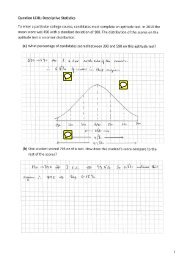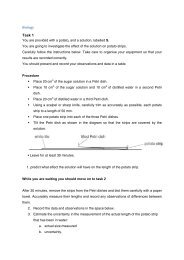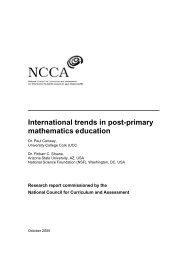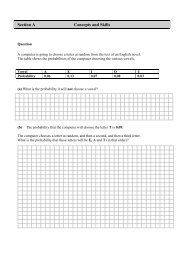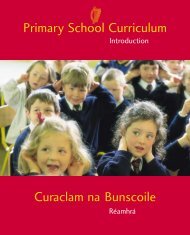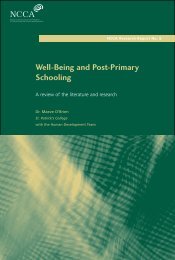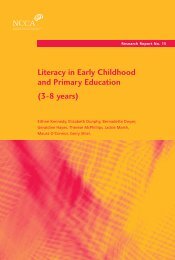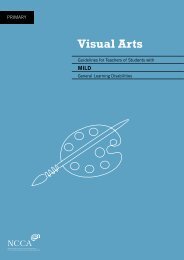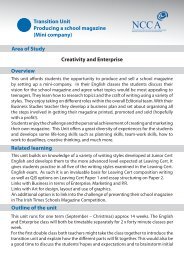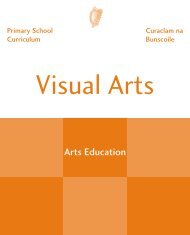Up and Away - National Council for Curriculum and Assessment
Up and Away - National Council for Curriculum and Assessment
Up and Away - National Council for Curriculum and Assessment
You also want an ePaper? Increase the reach of your titles
YUMPU automatically turns print PDFs into web optimized ePapers that Google loves.
214<br />
Class organisation<br />
Whole class.<br />
Individual.<br />
Theme<br />
Use with any of the Units of<br />
Work of the primary curriculum.<br />
Aims<br />
Review known vocabulary.<br />
Rein<strong>for</strong>ce word recognition<br />
skills.<br />
Practise speaking, reading <strong>and</strong><br />
writing about food <strong>and</strong> drink.<br />
Develop writing skills to<br />
sentence level.<br />
Materials needed<br />
Pictures of objects already<br />
learned, <strong>and</strong> matching word<br />
flash cards.<br />
Photocopy the sheet of blank<br />
flash cards on page 191.<br />
Class set of Worksheet F on<br />
page 209 (back to back).<br />
Preparation<br />
Cut up the sheet of blank flash<br />
cards.<br />
Notes<br />
Pupils will come up with words<br />
(in this example, food items)<br />
that have not been introduced<br />
to the class. Have blank A4<br />
sheets <strong>and</strong> flashcards available<br />
<strong>and</strong> ask pupils to draw the<br />
food items they are referring<br />
to.<br />
Stage 3 – Towards writing<br />
What is this? – writing sentences<br />
Focus Time<br />
40 minutes.<br />
Type of activity<br />
Matching activity.<br />
Writing practice.<br />
Approach<br />
1. Use picture cards to review words learned in previous classes.<br />
2. Ask pupils what day it is <strong>and</strong> on a blank sheet of A4 write in large<br />
print, ‘On Monday I eat’. Move a few of the picture cards to the<br />
end of the sentence <strong>and</strong> say, <strong>for</strong> example, “On Monday I eat<br />
chicken, vegetables <strong>and</strong> orange juice”.<br />
3. In turn pupils move pictures to the end of the sentence on the<br />
A4 sheet <strong>and</strong> say what they have to eat on that day of the week<br />
– see ‘Notes’ below.<br />
4. Spread out the picture cards in one area of the table. In another<br />
area of the table spread out the corresponding word flash cards.<br />
Read each word as it is put on the table. Then point to individual<br />
words <strong>and</strong> ask, “What is this?” Ask pupils to match the words to<br />
the pictures.<br />
5. Draw attention to the sentence on the A4 sheet. Move word<br />
flash cards to the end of the sentence <strong>and</strong> say, “On Monday I eat<br />
chicken, vegetables <strong>and</strong> orange juice”. Ask pupils to do the same.<br />
6. Repeat this around the room three times. On the third time give<br />
each pupil a copy of Worksheet F on page 209. Write the<br />
model sentence (‘On Monday I eat…’) across the first line of the<br />
page. Pupils copy the sentence on the following lines.<br />
7. Use the reverse side in the same way. Write what another pupil<br />
has to eat on the first line (e.g. ‘On Monday Sergiy eats bread,<br />
cheese <strong>and</strong> milk’.), which becomes the model <strong>for</strong> further writing<br />
practice.<br />
Extension<br />
Use a scrapbook to develop a class food journal:<br />
Different pages denote different days of the week <strong>and</strong><br />
pupils write in what they eat <strong>and</strong> drink.<br />
Pupils have their own pages <strong>and</strong> detail what they eat <strong>and</strong><br />
drink over the course of the week.<br />
‘Healthy food’ pages – pupils work together to list all the<br />
healthy food they eat.



